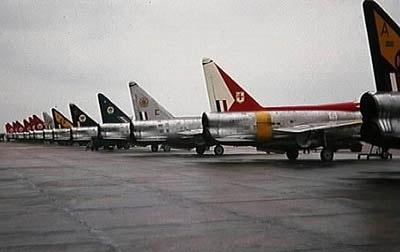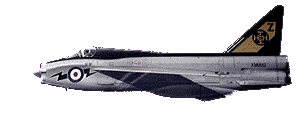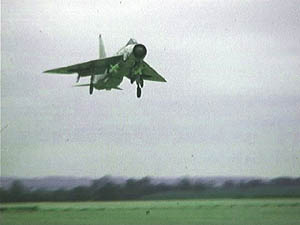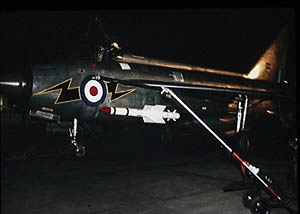![]()
 Spotlight:
Life with the Lightning
by
Derek
Hitchins
Spotlight:
Life with the Lightning
by
Derek
Hitchins
First posting after Henlow was RAF Duxford. They flew Hunters and Javelins, 65 and 64 Squadrons respectively. I, however, was in the Radio Servcing Flight. Luckily, that not only gave me an excellent insight into how the station worked, but it also gave me the opportunity to find my way about. One of the little items I found was Pat. Knowing a good thing when I saw it, I married her. Courtship was interesting, though. As Pat was a WRAF corporal, we could not be seen out together, and had to go forty miles for a cup of coffee! Looking back, that just added to the fun!
No sooner married than off on a nine-month, round Britain course on the Lightning. I was posted to 111 Squadron, the famous 'Treble One'. Great, if a bit daunting. I was the 'Weapon System Diagnostician'. My engineering boss was Bill Richardson, later the Chief Engineer of the RAF. Within minutes of me arriving, he went on a well-earned vacation, while I was left with thirteen Lightnings - all to myself! Uh...help!
By now, Pat and I had had our first baby - just. Pat found a lovely thatched cottage on the edge of the airfield. The house was idyllic, with an apple orchard out back, roses. Oh! and did I mention finger drains, an archaic plumbing system and no heating. In the winter evenings we huddled together under a blanket to keep warm. Great!
 Wattisham
was very busy. There were two Lightning squadrons, 56 and 111, plus a
Javelin squadron, 41. Nigel Field-Richards had been posted to 56 Squadron,
so we were doing equivalent jobs. Mike Graydon, later to be boss of the
RAF, was on 56 Squadron at the time, while we had greats like Bugs Bendell,
Pete Ginger and George Black on 111 Squadron.
Wattisham
was very busy. There were two Lightning squadrons, 56 and 111, plus a
Javelin squadron, 41. Nigel Field-Richards had been posted to 56 Squadron,
so we were doing equivalent jobs. Mike Graydon, later to be boss of the
RAF, was on 56 Squadron at the time, while we had greats like Bugs Bendell,
Pete Ginger and George Black on 111 Squadron.
 I
had as many flights as I could get in the two-seater. I even flew in the
right-hand seat at Aberporth, for the live firing, with George Black -
'Black Leader'. Unfortunately, we had a hang-fire and George chased me
down the ASP on landing. Like it was my fault?
I
had as many flights as I could get in the two-seater. I even flew in the
right-hand seat at Aberporth, for the live firing, with George Black -
'Black Leader'. Unfortunately, we had a hang-fire and George chased me
down the ASP on landing. Like it was my fault?
One of the perks was to join the ten-ton club - a novelty at the time. My run at over 1000mph was with Sam Lucas, who let me take over the controls for about three micro-seconds. Oh ye of little faith! Still, I managed to get quite a lot of hours on Lightings, not to mention the simulator - which I managed to land inverted at one time without the instructor noticing. Next pilot in had great trouble trying to take off!
 Not
too long after that Kennedy was assassinated. I was digging a Lighting
out of the runway at Wattisham at the time - they say you always remember
where you were...
Not
too long after that Kennedy was assassinated. I was digging a Lighting
out of the runway at Wattisham at the time - they say you always remember
where you were...
But mostly it was concentrated effort. Typical was a night operational turnround, the aim being to turnround as quickly as possible. There was great rivalry between the squadrons to get the shortest 'OTR'. We won.
Lightnings were fitted with refuelling probes to increase their radius of action and for deployments. A hive of activity occurred each night as we maintained and operated what was, essentially, a rather unreliable, very high performance double paraffin burner. Deployments to Cyprus were common - now that's hot. So hot that I ordered string vests for the lads to prevent them from burning on the Lighting metalwork. Stores thought string vests were winter-wear only, until a sergeant fried two eggs on the wing for a visiting VIP!
 There
seem to have been lots of parties. My dancing made up for lack of talent
with enthusiasm - at least, that's my story. Later postings included one
to, then, Elliott's at Rochester with thirteen SNCOs. We were monitoring
the development of Automatic Test Equipment (ATE) initially for the NIMROD.
We worked on ATE for Nimrod MR and F-111K, plus Jaguar and Harrier and
even VC10.
There
seem to have been lots of parties. My dancing made up for lack of talent
with enthusiasm - at least, that's my story. Later postings included one
to, then, Elliott's at Rochester with thirteen SNCOs. We were monitoring
the development of Automatic Test Equipment (ATE) initially for the NIMROD.
We worked on ATE for Nimrod MR and F-111K, plus Jaguar and Harrier and
even VC10.
Later still we went to RAF Staff College for a year, then at Bracknell. After Staff College, off the Chivenor in North Devon. I was i/c Aircraft Support Squadron, so of course I was responsible for deep third line Avon engine strip. My last tour was at RAF Cranwell, where I had started twenty-two years earlier as an apprentice. Very satisfying.